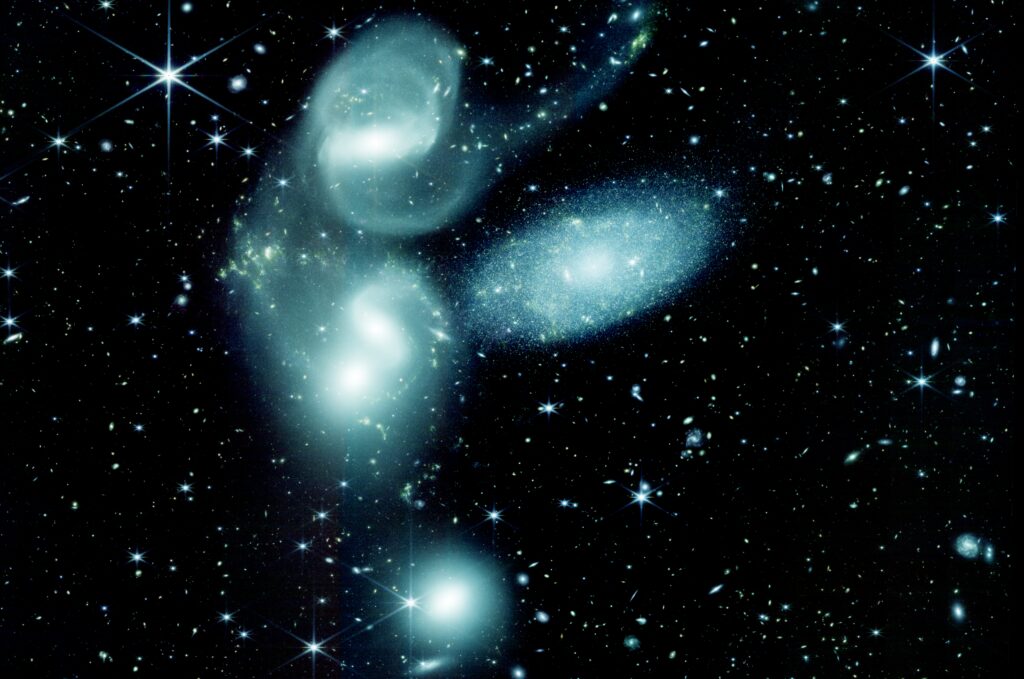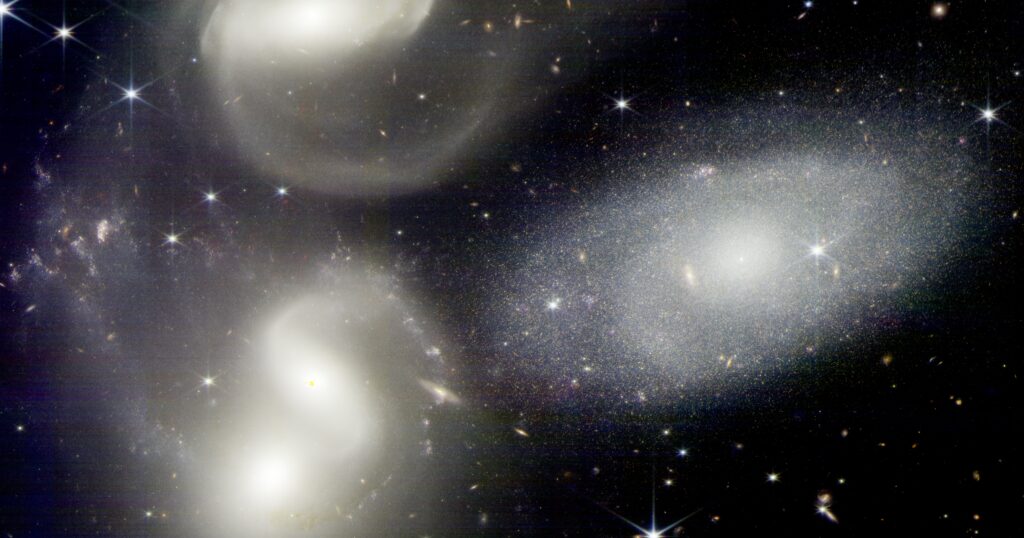Full 6 waveband Composite Image of Stephan’s Quintet
In the ERO release images of this group of galaxies by NASA, much to do was made about their interaction. In the NASA release, NIrCam (near IR) and MIRI (mid IR) data were included in the composite images. While it was briefly mentioned in the news release, not all these galaxies are interacting. Of the 5 galaxies in the group, only 4 are interacting with the 5th member, NGC-7320, 7x closer at 40 million light years. NGC-7320 is the spiral galaxy on the right (below). All galaxies in the initial release by the NASA imaging team included both NIrCam and MIRI data with the suggestion by inference that they are all interacting – this is not the case.
We downloaded and processed all the NIrCam image data from the public archive at STSci in all six wavebands available from the JWST observing run and feature some of those images here. We did not include MIRI data as that was already published by NASA’s JWST imaging team and is publicly available elsewhere.

6 waveband image of Stephan’s Quintet (with NGC-7320) in Pegasus. 4 of the 5 galaxies in this image represent the first and most famous of the HCG Compact Groups where visual inspection clearly shows the physical overlap and interaction. Four of the five galaxies in this image are 290 million light years distant while the fifth member, NGC-7320, is 7x closer at 40 million light years. Image details: (45 mb jpg, 13160x 8720 pixels), RBG image details: (900 nm, 1500 nm, 2000 nm, 2770 nm, 3560 nm and 4440 nm). Clicking the image opens the full 45 mb image.
First observed by French Astronomer Édouard Jean-Marie Stephan in 1877, “Stephan’s Quintet” is the first compact galaxy group discovered. Known more formally as Hickson Compact Groups, the properties and characteristics of these groups were first codified by Paul Hickson in 1982, to wit:
“Most compact groups contain a high fraction of galaxies having morphological or kinematical peculiarities, nuclear radio and infrared emission, and starburst or active galactic nuclei (AGN) activity. They contain large quantities of diffuse gas and are dynamically dominated by dark matter. They most likely form as subsystems within looser associations and evolve by gravitational processes. Strong galaxy interactions result and merging is expected to lead to the ultimate demise of the group. Compact groups are surprisingly numerous, and may play a significant role in galaxy evolution.”
Stephan’s Quintet is the first and most famous of the HCG Compact Groups where visual inspection clearly shows the physical overlap and interaction. Known as HCG 92, it is the most famous group on Hickson’s list of 100 objects.
Stephan’s Quintet at 0.9, 1.5 and 2.0 Microns

Stephan’s Quintet in the near Infrared (0.9, 1.5 and 2.0 microns) imaged by JWST with image processing by James Daly, Ph.D. Located in the constellation Pegasus, four of the five galaxies at 290 million light-years are physically interacting while the fifth member of the group, NGC-7320, is 7x closer at 40 million light years. Note: this display image is 1024×705 and links to the full image jpg with a size of 73 mb and dimensions of 14580×10044 pixels. Additional download options below.
Stephan’s Quintet at 2.7, 3.6 and 4.4 Microns

Stephan’s Quintet in the near Infrared (2.7, 3.6 and 4.4 microns) imaged by JWST with image processing by James Daly, Ph.D. Located in the constellation Pegasus, four of the five galaxies at 290 million light-years are physically interacting while the fifth member of the group, NGC-7320, is 7x closer at 40 million light years. Note: this display image is 1024×876 and links to the full image jpg with a size of 66 mb and dimensions of 14586×12491 pixels. Additional download options below.
NGC-7320 at 0.9, 1.5 and 2.0 Microns
Although there are 5 galaxies in the “group“, only 4 are interactive and gravitationally bound to each other. At 40 million light-years, the fifth member of the group, NGC-7320 is to the east (right) and is 7x closer than the other four. In the constellation Pegasus, at 290 million light-years, the other 4 galaxies are in the distant background. The distance metric between the NGC-7320 and the more distant galaxies cannot be more stark.
Note the stars in the closer spiral galaxy, clearly resolved while the same cannot be said of the more distant galaxies with only a hint of their stellar nature resolved by Webb’s 6.5 meter mirror as a granular or mottled appearance. A 3-D character can almost be seen if one looks at the west (left) side of the galaxy with the far more distant galaxy in the background.
NGC-7320 is known for its vibrant star formation, an example of which can be seen in the star forming regions along the north (top) edge. Clearly visible also are the galaxy’s spiral arms and the stars that populate them. An observation now commonplace in many JWST images are the background galaxies, their light redshifted from the visible into the near IR. This image is no exception with many visible in the distant background, JWST’s IR cameras able to penetrate the intervening gas and dust.

Spiral galaxy NGC-7320 at 40 million light years is 7x closer than the much more massive and distant quartet at 280 million light years. This image of NGC-7320 is in the Near Infrared at 3 discrete wavebands at 0.9, 1.5 and 2.0 microns. Note the clear resolution of the galaxy’s stars as myriad points of light compared to the much more distant background galaxies presenting with a granular or mottled appearance, hints of their true stellar nature. Note the star-forming regions along the galaxy’s north (top) edge. Display image with 1024×699 pixels links to full 11 mb jpg with 4780×3265 pixels.
NGC-7320 at 2.7, 3.6 and 4.4 Microns
The following image is stunning in detail and rich in content. Note the myriad background galaxies, completely revealed in this waveband, unhindered by any intervening gas and dust. JWST literally “sees through” the gas and dust of the foreground spiral galaxy. The galaxy’s star-forming regions are clearly visible as well as the central core region. It’s instructive to contrast and compare what details and insights can be gained by comparing the galaxy in the two wavelength regimes used to produce this image.

Spiral galaxy NGC-7320 at 40 million light years is 7x closer than the much more massive and distant quartet at 280 million light years. This image of NGC-7320 is in the Near Infrared at 3 discrete wavebands at 2.7, 3.6 and 4.4 microns. Note the stunning detail and clear resolution of the galaxy’s stars as myriad points of light compared to the much more distant background galaxies presenting with a granular or mottled appearance, hints of their true stellar nature. Display image with 1024×702 pixels links to full 7 mb jpg with 4780×3265 pixels.
Animated Comparison of NGC-7320 in Two Discrete Wavebands
With the penetrating power of the Infrared, the comparative, animated image of NGC-7320 is featured below. The shorter wavelength waveband (0.9, 1.5 and 2.0 microns), the galaxy’s spiral structure is visible with some of the star-forming regions presenting with the characteristic H-Alpha colors. The longer wavelengths at 2.7, 3.6 and 4.4 microns provide for almost complete transparency, allowing a more vibrant and stunning presentation of the galaxy’s individual stars and the distant background galaxies.
A definite 3D sense can be obtained viewing the left (west) edge of the galaxy when simultaneously looking at the more distant background galaxies.
For those background galaxies with a high-z, the longer wavelengths also allow for a deeper penetration into the cosmological past, revealing those galaxies that would have been otherwise redshifted into invisibility.

Animated composite of NGC-7320 in 2 discrete wavebands (description below). Image size 1200×822 pixels.
Interacting Quartet
The stars of NGC-7320 at 40 million light years distant are clearly resolved with JWST’s 6.5 meter gold-coated mirror. The interaction between NGC-7318A and B and NGC-7319 is clearly manifest on the west (left) side of the quartet as bright, star-forming regions. The tidal interaction has resulted in the ejection of stars, gas and dust, manifest as a stream to the southeast (top right) of NGC-7319.
The E0 elliptical galaxy NGC-7317, visible at the bottom (west) and separated from the interacting trio, interacts to a lesser degree with the other galaxies.

Interacting trio NGC-7318A, NGC-7318B and barred-spiral galaxy NGC-7319 (east, top) with spiral galaxy NGC-7320 in the foreground. Display image with 1024×594 pixels links to full 16 mb jpg with 6140×3564 pixels.

Interacting trio NGC-7318A, NGC-7318B and barred-spiral galaxy NGC-7319 (east, top) with spiral galaxy NGC-7320 in the foreground. Display image with 1024×538 pixels links to full 17 mb jpg with 6704×3520 pixels.
E0 Elliptical Galaxy NGC-7317
NGC-7317 is the western-most and least-interacting member of the quartet. Located in the galaxy’s mid-to-outer regions are many globular clusters. Seen as faint “stars”, they’re visible at magnitude 26.2 but completely unresolved at 290 million light years. The limiting magnitude of JWST is about magnitude 33, so they would be clearly visible. At 55 million light years, they’re visible as moths to a flame in this image of M-87, the giant elliptical galaxy in Virgo, made famous by that galaxy’s central black hole’s event horizon image produced by the EHT Collaboration.
Distant galaxies populate the rich background in this 6-waveband image (details below) with what seems to be a star-forming region in the extra-galactic space north of the galaxy (top).

E0 elliptical galaxy NGC-7317, the western-most and least-interacting member of the quartet. Note the interacting region to the north (top). 6 wave-band image size 5 mb jpg with 3696×2655 pixels.
Imaging Parameters
The first three of the six available infrared wavebands were used to produce the primary image at the top of the page. A six-waveband integrated image is available below and in the download options section below. The image data was processed with PixInsight according to standard RGB protocols and NASA standards for color imaging. These standards, like they are for visible-light imaging, set the blue, green and red according to increasing wavelength respectively.
900 nm (near IR, 0.9 microns just above visible limit) (Blue component)
1500 nm (near IR, 1.5 microns) (Green component)
2000 nm (near IR, 2.0 microns) (Red component)
2770 nm (near IR, 2.8 microns) (Blue component)
3560 nm (near IR, 3.6 microns) (Green component)
4440 nm (near IR, 4.44 microns) (Red component)
Full Composite, 6 waveband image of Stephan’s Quintet and NGC-7320

Six waveband integrated image of Stephan’s Quintet. The stars of NGC-7320 at 40 million light years distant are clearly resolved with JWST’s 6.5 meter gold-coated mirror. The interaction between NGC-7318A and B and NGC-7319 is clearly manifest on the west (left) side of the quartet as bright, star-forming regions. The tidal interaction has resulted in the ejection of stars, gas and dust, manifest as a stream to the southeast (top right) of NGC-7319. The elliptical galaxy NGC-7317, visible at the bottom (west) and separated from the interacting trio, interacts to a lesser degree with the other galaxies. This display image is 1024×876 pixels and links to the full 74 mb jpg with dimensions of 14586×12481 pixels. Additional download options below.
Download Options
Note: Image data, courtesy NASA and STSci. All image processing by James Daly, Ph.D. JWST image data used in this article from NASA’s ERO (Early Release Observations) program (attribution(s) below).
Stephan’s Quintet
Near IR (900 nm,1500 nm, 2000 nm), 3 waveband n-IR) Full Field JPG (89 mb, 14568×12481 pixels)
Near IR (900 nm,1500 nm, 2000 nm), 3 waveband n-IR) Full Field PNG (259 mb, 14568×12481 pixels)
Near IR (2700 nm, 3560 nm, 4400 nm), 3 waveband n-IR) Full Field JPG (66 mb, 14568×12481 pixels)
Near IR (2700 nm, 3560 nm, 4400 nm), 3 waveband n-IR) Full Field PNG (153 mb, 14568×12481 pixels)
Near IR (900 nm,1500 nm, 2000 nm, 2700 nm, 3560 nm, 4400 nm, 6 waveband n-IR) Full Field JPG (74 mb, 14568×12481 pixels)
Near IR (900 nm,1500 nm, 2000 nm, 2700 nm, 3560 nm, 4400 nm, 6 waveband n-IR) Full Field PNG (156 mb, 14568×12481 pixels)
NGC-7320
Near IR (900 nm, 1500 nm, 2000 nm, 3 waveband n-IR) Detailed Full Field JPG (3 waveband, 11 mb, 4780×3265 pixels)
Near IR (2700 nm, 3560 nm, 4400 nm, 3 waveband n-IR) Detailed Full Field JPG (3 waveband, 7 mb, 4780×3276 pixels)
Near IR (900 nm,1500 nm, 2000 nm, 2700 nm, 3560 nm, 4400 nm, 6 waveband n-IR) JPG Detailed Full Field (6 waveband, 9 mb, 5335×3540 pixels)
Near IR Animated Composite (900 nm, 1500 nm, 2000 nm <==> 2700 nm, 3560 nm, 4400 nm, 6 waveband n-IR) Animated GIF Detailed Full Field (6 waveband, 1.1 mb, 1200×822 pixels)
NGC-7317
Near IR (900 nm,1500 nm, 2000 nm, 2700 nm, 3560 nm, 4400 nm, 6 waveband n-IR) JPG Detailed Full Field (6 waveband, 5 mb, 3696×2655 pixels)
Near IR (900 nm,1500 nm, 2000 nm, 2700 nm, 3560 nm, 4400 nm, 6 waveband n-IR) PNG Detailed Full Field (6 waveband, 12 mb, 3696×2655 pixels)
Attributions
”The Early Release Observations and associated materials were developed, executed, and compiled by the ERO production team: Hannah Braun, Claire Blome, Matthew Brown, Margaret Carruthers, Dan Coe, Joseph DePasquale, Nestor Espinoza, Macarena Garcia Marin, Karl Gordon, Alaina Henry, Leah Hustak, Andi James, Ann Jenkins, Anton Koekemoer, Stephanie LaMassa, David Law, Alexandra Lockwood, Amaya Moro-Martin, Susan Mullally, Alyssa Pagan, Dani Player, Klaus Pontoppidan, Charles Proffitt, Christine Pulliam, Leah Ramsay, Swara Ravindranath, Neill Reid, Massimo Robberto, Elena Sabbi, Leonardo Ubeda. The EROs were also made possible by the foundational efforts and support from the JWST instruments, STScI planning and scheduling, and Data Management teams.”
Note: Image data, courtesy NASA and STSci. All image processing by James Daly, Ph.D. JWST image data used in this article from NASA’s ERO (Early Release Observations) program.



